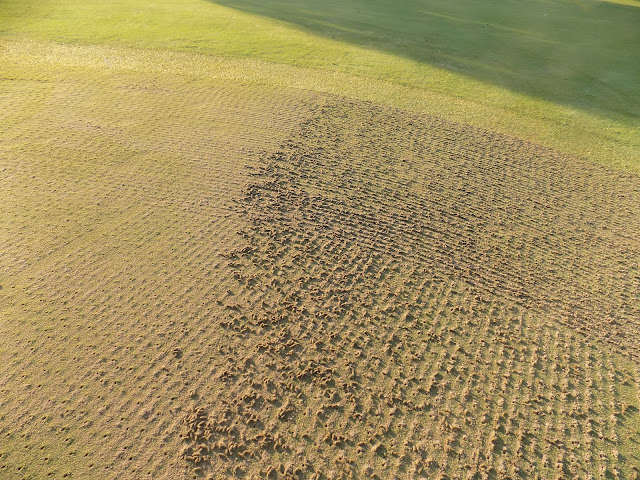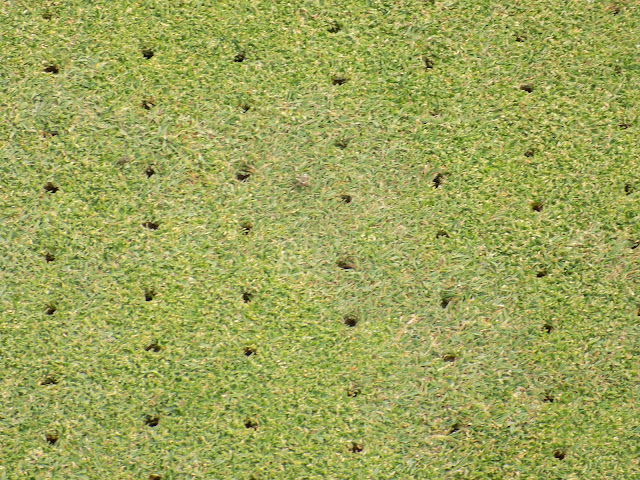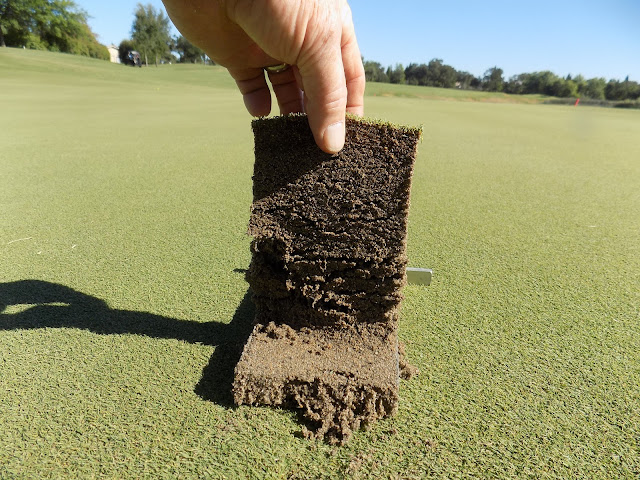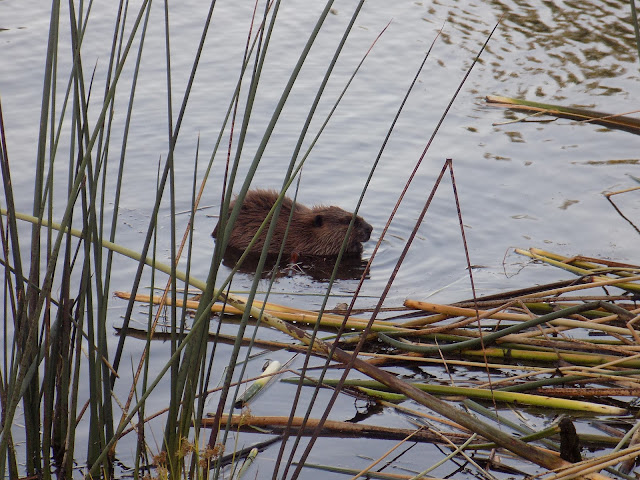It was indeed just a year ago this week when we started the sprigging process to convert our fairways at Granite Bay Golf Club from a mix of cool season turf varieties to warm season Santa Anna Hybrid Bermuda. The process we used to convert the fairways is called sprigging which involved shredding big rolls of sod into little pieces, disking them into prepared soil, rolling, flood watering followed by allot of fertilizer, more watering and rolling, then BOOM! a fairway. Sounds simple, but in reality, it was a stressful time filled with learning curves and setbacks and questions such as "is this going to work?".
Fast forward a year and we have the foundation of what will be, with a little more time to fine tune and mature, some extremely fast, firm and sustainable fairways that wont be susceptible to the stresses of summer any longer, along with superior playability year round to our previous cool season blend.
 |
The first big roll of Santa Anna Hybrid Bermuda about to be made into sprigs on #1 fairway
June 28, 2021 |
 |
| Starting the sprigging on #1. GM Kevin Marshall is so excited. |
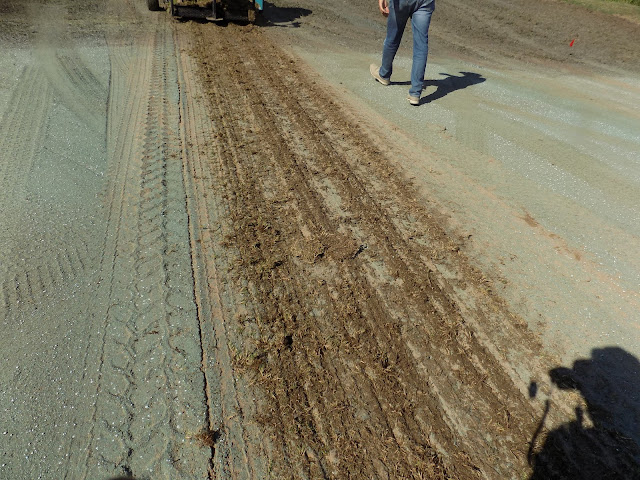 |
| Hard to believe this turned into fairway turf. |
 |
| Fairways we started playing on 4 - 5 months later. |
 |
| Fairways we are playing on a year later. |
 |
| 10 months after sprigging |
Fine Tuning Continues
We have been continuing to fine tune this young golf course since the 2021 renovation and are starting to see some expected and unexpected issues that will need immediate and long term attention. The expected items include irrigation of Hybrid Bermuda fairways directly adjacent to cool season rough and installation of drainage to move surface water off of the plying surfaces where it now accumulates.
Surface Drainage
Drainage work after a renovation or on a new golf course is pretty normal. These areas become evident after either sustained rain in the winter or after you start irrigating. We didn't get much rain this past season and when it did rain it rained in buckets, then dried out relatively quickly. Although many of these drainage areas were known, we started seeing others when we started to irrigate. We've been making irrigation adjustments to buy some time knowing that we would sooner rather then later have to start installing surface drainage. Sooner has come, and we will begin installing drains on #10 approach and #12 fairway the week of July 4, 2022. I'll do a course update then on process, plans and progress of this surface drainage work.
 |
Approach on #10. The contours of this area in particular were all changed in 2021 and the necessity of a surface drain very predictable. If we reduce irrigation in the area too much to dry the approach area down, the tall fescue surrounding the bunker at the top of the picture will really struggle. This is a great example of an area that needs a surface drain now, and some supplemental irrigation to independently water the fescue in the future |
Supplemental Irrigation
I've mentioned irrigation on the edges of fairways and rough as being a big challenge. This challenge won't go away with irrigation programing and adjustments in many cases. Bottom line we have cool season and warm season turf growing right next to one another with different irrigation needs and wants that are irrigated with the same irrigation heads in many cases. The above picture illustrates this well. The ultimate solution will basically be supplemental irrigation in our cool season rough areas that will provide adequate independent irrigation.
I am hoping to make a starting push on this work during the Winter of 2022. Much more to come on this as it will be a key to our success in the future. Below illustration of the beginning of the fairway on #10 is another simple example of what we are facing now, and planning for the future solutions.
 |
Above is a copy of a new updated irrigation map. Blue 10F #'s indicate fairway head's, red 10R #'s indicate rough head's. If you locate 10F1 & 10F2 you will see by their proximity to the rough / fairway line that they irrigate both cool season rough turf as well as warm season fairway turf. One area can get dry very easily, while simultaneously the other is wet. Short term help can be achieved by installing a surface drain. Long term solution will be installing supplemental irrigation for the cool season rough. |
Unexpected Circumstances
The one unexpected issue I have observed so far with our new Santa Anna Hybrid Bermuda fairways is seedhead production and how it can affect aesthetics particularly in the spring. Most varieties of Hybrid Bermuda do produce sterol seed heads on stems or stalks that don't cut very well when mowing and leave a straw like appearance.
The Santa Lucia Preserve Golf Club in Carmel Valley is a golf club I toured in 2017 in preparation for our Santa Anna conversion as they had converted their fairways to Santa Anna a few years prior. The Santa Anna fairways at "The Preserve" are what I consider the gold standard for Santa Anna fairways, and what we are striving for here at Granite Bay. They are dealing with the same issues like seedhead production and irrigating cool season rough next to their Santa Anna Fairways. The Preserve's Superintendent shared with me last week, a study that was just concluded at The Preserve by
Dr. James Beard from UCR on Santa Annas seedhead production. Dr. Beard and his department are probably the most active turfgrass researcher's in California and a valuable resource for Golf Course Superintendents in the state on a variety of turf issues.
The study's results will be available shortly with good news on timing and application of certain products that can prevent seedhead production and the straw coloration associated with it.
 |
| Above is a good closeup of Santa Anna seedhead. |
 |
| Clean Santa Anna Fairway after seedheads were removed with vertical mowing |
Granite Bay Golf Club. What a Treat!
Last week I got these pictures of Granite Bay wildlife one morning at sunrise and wanted to share.
Conclusion
The good news, as far as I am concerned, is we have a superior turf to what we had and complete irrigation coverage and system, including a new pump station to irrigate this turf. Additionally we are in a part of the State, that at least at the moment, have a adequate water source to irrigate with. That being said, we will have a water conservation story to tell this year and in the future at Granite Bay, and have an even better story to tell farther in the future when we have the enhancements in place that I spoke of above.
The first birthday of fairway sprigging brings to my mind at least, of how far we have come since last year. There is much left to be done which seems formidable at times, but much has been accomplished since that first sprig hit the ground on June 28th, 2021. Our work continues. Thanks for your patience and support. The Best Is Yet To Come.


